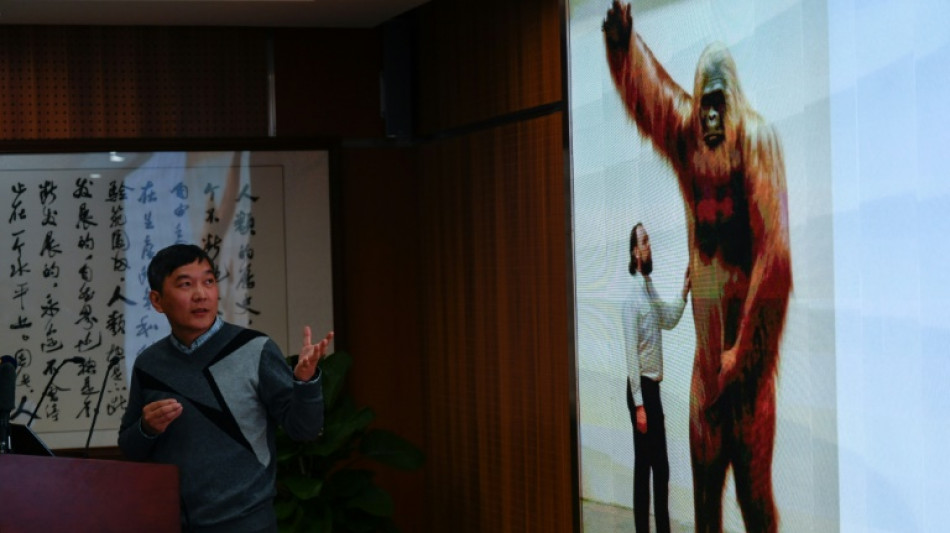
-
 Biden clears Ukraine for long-range missile strikes inside Russia
Biden clears Ukraine for long-range missile strikes inside Russia
-
'Nobody can reverse' US progress on clean energy: Biden

-
 Biden allows Ukraine to strike Russia with long-range missiles: US official
Biden allows Ukraine to strike Russia with long-range missiles: US official
-
Biden clears Ukraine for missile strikes inside Russia

-
 Ukrainians brave arduous journeys to Russian-occupied homeland
Ukrainians brave arduous journeys to Russian-occupied homeland
-
'Devil is in the details,' EU chief says of S.America trade deal

-
 Toll in Tanzania building collapse rises to 13, survivors trapped
Toll in Tanzania building collapse rises to 13, survivors trapped
-
'Red One' tops N.America box office but could end up in the red

-
 Biden begins historic Amazon trip amid Trump climate fears
Biden begins historic Amazon trip amid Trump climate fears
-
Macron defends French farmers in talks with Argentina's Milei

-
 India and Nigeria renew ties as Modi visits
India and Nigeria renew ties as Modi visits
-
Typhoon Man-yi weakens as it crosses Philippines' main island

-
 迪拜棕榈岛索菲特美憬阁酒店: 五星級健康綠洲
迪拜棕榈岛索菲特美憬阁酒店: 五星級健康綠洲
-
The Retreat Palm Dubai MGallery by Sofitel: Пятизвездочный велнес-оазис

-
 The Retreat Palm Dubai MGallery by Sofitel: A five-star wellness Oasis
The Retreat Palm Dubai MGallery by Sofitel: A five-star wellness Oasis
-
Power cuts as Russian missiles pound Ukraine's energy grid

-
 Biden in historic Amazon trip as Trump return sparks climate fears
Biden in historic Amazon trip as Trump return sparks climate fears
-
India hails 'historic' hypersonic missile test flight

-
 Debt-saddled Laos struggles to tame rampant inflation
Debt-saddled Laos struggles to tame rampant inflation
-
India's vinyl revival finds its groove

-
 Climate finance can be hard sell, says aide to banks and PMs
Climate finance can be hard sell, says aide to banks and PMs
-
Egypt's middle class cuts costs as IMF-backed reforms take hold

-
 Dinosaur skeleton fetches 6 million euros in Paris sale
Dinosaur skeleton fetches 6 million euros in Paris sale
-
Trump's Republican allies tread lightly on Paris pact at COP29

-
 China's Xi urges APEC unity in face of 'protectionism'
China's Xi urges APEC unity in face of 'protectionism'
-
Farmers target PM Starmer in protest against new UK tax rules

-
 UN climate chief urges G20 to spur tense COP29 negotiations
UN climate chief urges G20 to spur tense COP29 negotiations
-
Philippines warns of 'potentially catastrophic' Super Typhoon Man-yi

-
 Tens of thousands flee as Super Typhoon Man-yi nears Philippines
Tens of thousands flee as Super Typhoon Man-yi nears Philippines
-
Gabon votes on new constitution hailed by junta as 'turning point'

-
 Tens of thousands flee as Typhoon Man-yi nears Philippines
Tens of thousands flee as Typhoon Man-yi nears Philippines
-
Is Argentina's Milei on brink of leaving Paris climate accord?

-
 Fitch upgrades Argentina debt rating amid economic pain
Fitch upgrades Argentina debt rating amid economic pain
-
Trump picks Doug Burgum as energy czar in new administration

-
 At summit under Trump shadow, Xi and Biden signal turbulence ahead
At summit under Trump shadow, Xi and Biden signal turbulence ahead
-
Xi warns against 'protectionism' at APEC summit under Trump cloud

-
 Xi, Biden at Asia-Pacific summit under Trump trade war cloud
Xi, Biden at Asia-Pacific summit under Trump trade war cloud
-
Leftist voices seek to be heard at Rio's G20 summit

-
 Boeing strike will hurt Ethiopian Airlines growth: CEO
Boeing strike will hurt Ethiopian Airlines growth: CEO
-
US retail sales lose steam in October after hurricanes

-
 Spate of child poisoning deaths sparks S.Africa xenophobia
Spate of child poisoning deaths sparks S.Africa xenophobia
-
Comedian Conan O'Brien to host Oscars

-
 Gore says 'absurd' to hold UN climate talks in petrostates
Gore says 'absurd' to hold UN climate talks in petrostates
-
Global stocks struggle after Fed signals slower rate cuts

-
 China tests building Moon base with lunar soil bricks
China tests building Moon base with lunar soil bricks
-
Oil execs work COP29 as NGOs slam lobbyist presence

-
 Gore says climate progress 'won't slow much' because of Trump
Gore says climate progress 'won't slow much' because of Trump
-
'Megaquake' warning hits Japan's growth

-
 Stiff business: Berlin startup will freeze your corpse for monthly fee
Stiff business: Berlin startup will freeze your corpse for monthly fee
-
Dominican Juan Luis Guerra triumphs at 25th annual Latin Grammys


Late apes: Biggest primate ever died off due to 'huge mistake'
The largest primate ever to walk the Earth went extinct because it could not adapt to its changing environment, with the mighty beast reduced to living off bark and twigs before dying off, scientists said on Wednesday.
Gigantopithecus blacki, which stood three metres tall (10 feet) and weighed up to 300 kilogrammes (660 pounds), thrived in the forests of southern Asia until a little more than 200,000 years ago.
Exactly why the great ape died off after flourishing for hundreds of thousands of years has been one of the lasting mysteries of palaeontology ever since a German scientist first stumbled on one of its teeth at a Hong Kong apothecary in the 1930s.
The molar was so massive it was being sold as a "dragon's tooth".
"It was three to four times bigger than the teeth from any great ape," Renaud Joannes-Boyau, a researcher at Australia's Southern Cross University, told AFP.
"That intrigued him and that's where all this research started," said Joannes-Boyau, a co-author of a new study in the journal Nature.
All that has been found of the Gigantopithecus since are four partial jawbones and around 2,000 teeth, hundreds of which were discovered inside caves in southern China's Guangxi province.
Even after a decade of excavations in these caves, the cause of the ape's extinction remained elusive, said the study's co-lead author Yingqi Zhang of China's Institute of Vertebrate Palaeontology and Palaeoanthropology.
- Huge apes can't jump -
Seeking to establish a timeline of the animal's existence, the team of Chinese, Australian and US scientists collected fossilised teeth from 22 caves.
The team used six different techniques to determine the age of the fossils, including a relatively new method called luminescence dating which measures the last time minerals were exposed to sunlight.
The oldest teeth dated back more than two million years, while the most recent were from around 250,000 ago.
Now the researchers can tell "the complete story about Gigantopithecus's extinction" for the first time, Zhang told AFP in his office in Beijing.
They established that the animal's "extinction window" was between 215,000 and 295,000 years ago, significantly earlier than previously thought.
During this time, the seasons were becoming more pronounced, which was changing the local environment.
The thick, lush forest that Gigantopithecus had thrived in was starting to give way to more open forests and grassland.
This increasingly deprived the ape of its favourite food: fruit.
The huge animal was bound to the ground, unable swing into the trees for higher food.
Instead, it "relied on less nutritious fall-back food such as bark and twigs," said Kira Westaway, a geochronologist at Australia's Macquarie University and co-lead author.
Zhang said this was a "huge mistake" which ultimately led to the animal's extinction.
- Clever relative -
The primate's size made it difficult to go very far to search for food -- and its massive bulk meant that it needed plenty to eat.
Despite these challenges, "surprisingly G. blacki even increased in size during this time," Westaway said.
By analysing its teeth, the researchers were able to measure the increasing stress the ape was under as its numbers shrunk.
They also compared Gigantopithecus' fate to its orangutan relative, Pongo weidenreichi, which handled the changing environment far better.
The orangutan was smaller and more agile, able to move swiftly through the forest canopy to gather a variety of food such as leaves, flowers, nuts, seeds, and even insects and small mammals.
It became even smaller over time, thriving as its massive cousin Gigantopithecus starved.
Westaway emphasised that it was important to understand the fate of the species that came before us -- particularly "with the threat of a sixth mass extinction event looming over us".
A.Samuel--CPN
